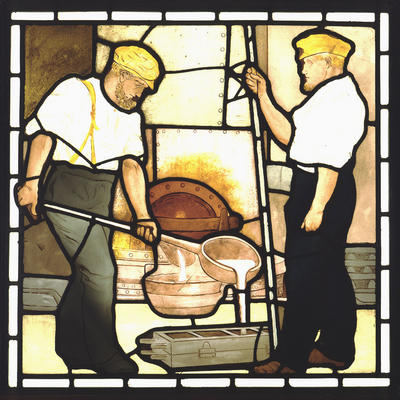
The Iron Moulders, a stained glass window by Stephen Adam, c 1878.
The window was one of twenty designed for Maryhill Burgh Halls which are now in the collections of the People's Palace. Each window showed a different trade practiced in the burgh, and this one shows men pouring molten iron into moulds.
Glasgow became a centre of the iron moulding (also called iron founding or iron casting) industry in the 18th century. The industry was given a great boost after the hot-blast process of iron smelting was patented in 1828, as iron became cheaper and more number one pig iron (necessary for fine castings) was made. In Maryhill several foundries were established along the Forth and Clyde Canal, including the Kelvin Foundry near Lochburn Road, the Springbank Iron Works at Queen's Cross, the Maryhill Foundry near Lochburn Park and the Firhill Foundry at Firhill Road.
Reference: 621.86.24
Reproduced with the permission of Glasgow City Council, Glasgow Museums
Keywords:
Firhill Foundry, Forth and Clyde Canal, hot-blast process, iron casting, iron founders, iron moulders, iron moulding, iron smelting, iron workers, Kelvin Foundry, Maryhill Burgh Halls, Maryhill Foundry, Springbank Iron Works, stained glass windows
You have 0 images in your photo album.